The Stoner Canon: Over 100 Trippy Movies, Albums, Books, TV Shows, and More

This article originally ran in 2015, but you know why we’re republishing it today. We’ve updated it to include even more trippy titles.
Pot has evolved from rebellious drug to mildly rebellious drug to widely legal aperitivo, but popular notions about what constitutes the best of stoner culture too often predictably rehash the Pink Floyds and Spicolis of the world.
So let’s expand our minds. With a perspective that acknowledges both the classics as well as the recent outpouring of weed-centric entertainment (and looks deeper than Cheech and Chong — those movies do not hold up), here are 101 cultural keys to unlocking the zonked headspace.

A Brief History of Seven Killings, Marlon James (2014)
Marlon James’s Jamaica-spanning novel A Brief History of Seven Killings is one of those books you can smell. Whether you’re following along with gangsters’ murder plot to assassinate a very Marley-like singer or riding shotgun in shady businessman Alex Winston’s Porsche, marijuana is always there, hovering over this sprawling, perspective-shifting novel. Given its kaleidoscopic and episodic nature, skipping around from place to place and mind to mind sets it up perfectly for an unequivocally eerie (though not especially irie) read. In case you need more convincing, James made you a mixtape.

A Brief History of Seven Killings, Marlon James (2014)
Marlon James’s Jamaica-spanning novel A Brief History of Seven Killings is one of those books you can smell. Whether you’re following along with gangsters’ murder plot to assassinate a very Marley-like singer or riding shotgun in shady businessman Alex Winston’s Porsche, marijuana is always there, hovering over this sprawling, perspective-shifting novel. Given its kaleidoscopic and episodic nature, skipping around from place to place and mind to mind sets it up perfectly for an unequivocally eerie (though not especially irie) read. In case you need more convincing, James made you a mixtape.

A Field Guide to Getting Lost, Rebecca Solnit (2005)
In her memoir, A Field Guide to Getting Lost, Rebecca Solnit is here to provide you with a really poetic excuse for why you are always late to things. The book is a celebration of all sorts of experiences that traditionally (when you’re not stoned) induce panic: losing the map, setting out without a destination in mind, confronting the unknown. Solnit revels in the vast gray areas of contradiction (“To calculate on the unforeseen,” she writes, “is perhaps exactly the paradoxical operation that life most requires of us.”) and invites us to question whether getting “lost,” in every sense of the word, must always be such a bad thing. Burn your maps, trash your GPS, and … start practicing your apology for walking two miles in the wrong direction on the way to brunch.
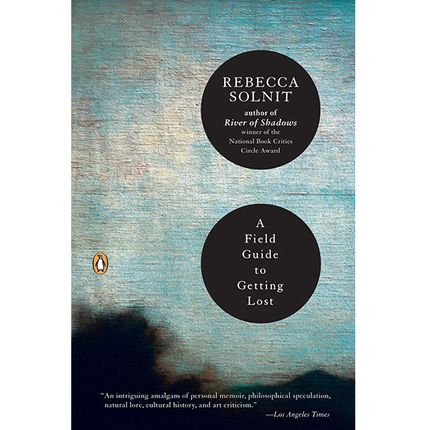
A Field Guide to Getting Lost, Rebecca Solnit (2005)
In her memoir, A Field Guide to Getting Lost, Rebecca Solnit is here to provide you with a really poetic excuse for why you are always late to things. The book is a celebration of all sorts of experiences that traditionally (when you’re not stoned) induce panic: losing the map, setting out without a destination in mind, confronting the unknown. Solnit revels in the vast gray areas of contradiction (“To calculate on the unforeseen,” she writes, “is perhaps exactly the paradoxical operation that life most requires of us.”) and invites us to question whether getting “lost,” in every sense of the word, must always be such a bad thing. Burn your maps, trash your GPS, and … start practicing your apology for walking two miles in the wrong direction on the way to brunch.
Marina Abramovic at the Museum of Modern Art (2010)
For 736 hours, New Age–like guru artist Marina Abramovic hypnotized the mass public into thinking that sitting across from her in MoMA’s atrium and looking at her would be enough to carry them away to ecstatic heights of self-revelation. It seemed to work, as people left crying, confused, shaken, stirred. You might’ve hated every second of it, but grant that Abramovic tapped into something deep, ritualistic, and ancient in us: the need to belong, get swept up in the mass hysteria of would-be religion, feeling like missionaries, spreading the word, given confirmation, and something like mother love.
Adventure Time (2010–present)
Yes, it’s a kids show, and yes, it’s way, way more than that. This Cartoon Network hit mainly focuses on the Technicolor exploits of Finn and his shape-shifting best friend Jake the Dog as they charge through the Land of Ooo saving the day, cheering its inhabitants up, and trying to impress a girl or two. But keep watching, and in between all the laughing and shouting and faintly D&D adventuring, something more complex emerges: a compelling exploration of friendship and the value of living a spontaneous life. As Adventure Time, again, ostensibly a children’s cartoon, reminds viewers time and time again, the unknown shouldn’t be feared; it should be embraced. (Available to stream on Cartoon Network, Hulu, and Max.)
African Herbsman, Bob Marley and the Wailers (1973)
African Herbsman is a singles compilation put out by Island shortly after the release of Catch a Fire, and as such is the indica to Catch a Fire’s sativa; a lighter set that represents some of dub mad professor Lee “Scratch” Perry’s earliest work with the Wailers and sunnier, more flowing versions of later albums cuts like “Lively Up Yourself” and “Trenchtown Rock.” The vibe is deeper — the groove is the reggae equivalent of couchlock — and packed with Bunny Wailer’s psych-tinged vocal flourishes. Strident Bob has his place. So too, as African Herbsman proves, does the singer in his mellower incarnations.
Akira (1988)
This animated 1988 sci-fi epic was pivotal in the rise of manga and anime in the U.S. and elsewhere. An expansive dystopian drama set in a post-nuclear Neo-Tokyo, it was ambitious, eye-popping, dark — and impossible to dismiss as so much kid-friendly piffle. It was also, as it so happens, an incredible movie to see high. The film’s intricate visual design, dense plotting, apocalyptic overtones, and occasional forays into body horror made it a uniquely psychedelic experience. (Available to stream on Hulu and to rent on iTunes.)
The Ancient Secret of the Flower of Life, Vol. 1, Drunvalo Melchizedek (1990)

On another day, the choice here might’ve been Gary Zukav’s The Dancing Wu Li Masters or Daniel Pinchbeck’s Breaking Open the Head, but Jaden Smith is a Melchizedek fan, so we’ll go with this one, the sacred nonfiction text of our new New Age. In it, the author reveals ancient “knowledge” cribbed from Atlantis, the hidden geometry that governs existence, and other esoterica that, if utilized correctly, might allow, among other lovely things, the Mer-Ka-Ba to become a living field of light. And wouldn’t that be nice?

The Ancient Secret of the Flower of Life, Vol. 1, Drunvalo Melchizedek (1990)
On another day, the choice here might’ve been Gary Zukav’s The Dancing Wu Li Masters or Daniel Pinchbeck’s Breaking Open the Head, but Jaden Smith is a Melchizedek fan, so we’ll go with this one, the sacred nonfiction text of our new New Age. In it, the author reveals ancient “knowledge” cribbed from Atlantis, the hidden geometry that governs existence, and other esoterica that, if utilized correctly, might allow, among other lovely things, the Mer-Ka-Ba to become a living field of light. And wouldn’t that be nice?
Antiques Roadshow (1997–present)
Who are these people? Where do they get all this stuff? How much is it worth? Episode after episode, PBS’s Antiques Roadshow shows that those are totally engrossing questions. And the aforementioned stuff is so weird sometimes! An ancient weapon? A toilet-paper roll that the Beatles refused to use because it was “too hard and shiny”? Watching Roadshow gives you a chance to go rifling through America’s attic. (Available to stream on PBS and to purchase on Amazon.)
ATLiens, Outkast (1996)
André 3000 isn’t really into weed, and he said as much on ATLiens’ title track. (“No drugs or alcohol so I can get the signal clear as day,” he raps.) The irony, of course, is that this an album that seems suspended in smoke. Outkast might have gotten weirder (Speakerboxxx/The Love Below) and harder (Stankonia), but they never sounded more spacey than they did on the likes of “Wheelz of Steel” and “Elevators (Me & You).” (Besides, André’s erstwhile partner Big Boi never quit smoking, so don’t let Dre’s abstainining kill your buzz.)
Avatar (2009)
Even if you don’t have a 3-D Imax projector in your living room, the top-grossing movie of all time still looks pretty sweet on home video, especially after a few puffs of your preferred strain of unobtainium. Pandora’s floating mountains, pterodactyls, blue-skinned hippie-creatures, and glow-in-the-dark plants seem to have been designed expressly with your heightened senses in mind. And if being high makes it hard to follow the plot, consider that a bonus. (Available to stream on Disney+ and Max and to rent on Amazon, iTunes, YouTube and Google Play.)
Bangerz, Miley Cyrus (2013)
Say what you will about Miley Cyrus, who over time reinvented herself as a millennial stoner icon, but she made this decade’s quintessential album about chilling out. Alongside executive producer Mike Will, Miley remade her sound into a throbbing, snapping collage of Bangerz. “FU” in particular is like dubstep meets Winehouse, and it’s fantastically overpowering.

The Beach Bum (2019)
What kind of stoner are you: a jokester? A philosopher? A hedonist? In The Beach Bum, Matthew McConaughey’s Moondog is all of them and more — and always puffing on something. So whether you want to laugh about fatherhood and shark attacks or ponder the beauty of life, Moondog’s the perfect smoke-session partner. (Available to stream on Max and to rent on Amazon and iTunes.)
The Big Lebowski (1998)
“Sometimes there’s a man, well, he’s the man for his time and place.” And such is one of the ways to introduce Jeffrey “the Dude” Lebowski, the Coen brothers’ supremely chill, White Russian–swilling, Creedence-loving, malapropism-spouting, bowling-enthusiast stoner-hero who finds himself in the midst of a Raymond Chandler–esque caper. It’s a film that rewards multiple viewings, with so many tiny details floating to the surface, like when the Dude accidentally tosses a joint on the diner counter along with some change. Then there are the out-there theories, like Donny being a figment of Walter’s imagination, which, if you think about it, man … (Available to stream on Hulu ad Peacock and to rent on Amazon, iTunes, YouTube, and Google Play.)
Blackboard Jungle Dub, Lee Perry and the Upsetters (1973)
Jamaican producer Lee “Scratch” Perry is one of the sonic originators of dub, the offshoot of reggae that focuses on mostly instrumental remixes of songs that emphasize bass, drums, and echo-heavy manipulations. This 1973 album — cut with Scratch’s house band the Upsetters, some of whom would later join Bob Marley’s Wailers — is one of the finest examples of the genre’s embryonic years, featuring tracks drenched in reverb and skitchy percussion. Plus, midway through, you get “Pop Goes the Weasel,” rendered here as “Pop Goes the Dread Dub.”
Blade Runner (1982)
Finding one boring frame anywhere in Ridley Scott’s gorgeous neo-noir retro-futurist masterpiece would be harder than tracking down a Nexus 6 replicant in rainy, dystopian Los Angeles. There was enough imaginative art direction in Blade Runner to inspire practically every sci-fi movie made since, so it should provide more than enough visual stimuli — fireballs over the L.A. skyline, animatronic owls, unicorns — for an evening on your couch. Also recommended: listening to Vangelis’s seminal synth score through a nice pair of headphones. (Available to rent on Amazon, iTunes, YouTube, and Google Play.)

The Book of Genesis, illustrated by Robert Crumb (2009)
Crumb was the key cartoonist of the high ‘60s, the man responsible for the iconic Mr. Natural. His neuroses — both sexual and social — finally found their perfect match in, of all things, the Bible. Gorgeously drawn in his inimitable style and acute in its characterizations, Crumb’s adaptation of the Book of Genesis is his heaviest effort, and makes the overt psychedelia of his earlier work seem almost psychically tame in comparison.
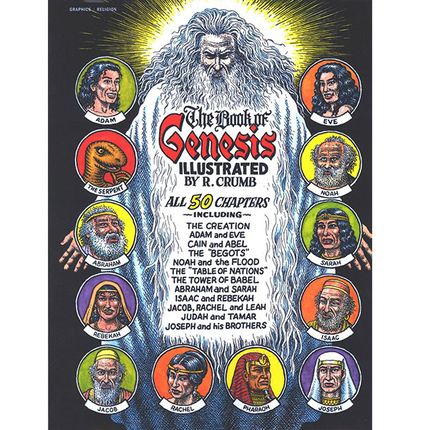
The Book of Genesis, illustrated by Robert Crumb (2009)
Crumb was the key cartoonist of the high ‘60s, the man responsible for the iconic Mr. Natural. His neuroses — both sexual and social — finally found their perfect match in, of all things, the Bible. Gorgeously drawn in his inimitable style and acute in its characterizations, Crumb’s adaptation of the Book of Genesis is his heaviest effort, and makes the overt psychedelia of his earlier work seem almost psychically tame in comparison.

Bottoms (2023)
A comedy with actual jokes. Bottoms, starring Ayo Edebiri and Rachel Sennott as loser lesbians who start a fight club to pick up chicks, is a comedy comedy. When you’re blazed, you don’t want any feelings getting in the way of a good laugh, and that’s what this provides. Everyone is doing the most, from Marshawn Lynch as the reluctant mentor, to Nicholas Galitzine’s camp version of bro, to the fact that our heroes murder an entire football team at the end of the movie. (Available to stream on MGM+)
Boyhood (2014)
“A three-hour meditation on masculinity, motherhood, and growing up in America” doesn’t exactly sound like a hard sell to stoners — but Richard Linklater’s 2014 film is so pot-friendly that the DVD might as well come with a pack of Zig-Zags. The pacing is simultaneously brisk and considerate, the cinematography presents real life as a nostalgic, honey-dipped landscape, and the story of Mason and his fractured family reelin’ in the years is surreal in the sense that the passage of time is truly mind-expanding. Mason’s journey from rascally, long-haired child to quiet, artistic rebel rings true for anyone who’s ever realized that following the status quo isn’t as important as trying to, you know, feel something. (Available to stream on AMC+ and the Roku Channel and to rent on iTunes, YouTube, and Google Play.)

Breakfast of Champions, Kurt Vonnegut (1973)
Like The Truman Show and The Matrix, this 1973 novel imagines what life would be like for someone who suddenly believes they’re living in a universe where free will isn’t a given. Except rather than TV satire or cyberpunk fantasy, Vonnegut focuses on an Ohio car salesman who uses this crack in the cosmic egg as invitation to go on a delusional destructive rampage. (Though, to be fair, there’s a fair amount of sci-fi in BOC.) Like all of Vonnegut’s works, the book makes you laugh at life while simultaneously sneaking in some solid humanist vibes. Also, there are a lot of dick jokes and funny drawings.
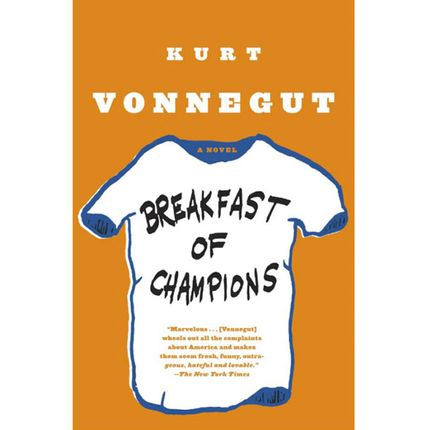
The Breakfast of Champions, Kurt Vonnegut Jr. (1973)
Like The Truman Show and The Matrix, this 1973 novel imagines what life would be like for someone who suddenly believes they’re living in a universe where free will isn’t a given. Except rather than TV satire or cyberpunk fantasy, Vonnegut focuses on an Ohio car salesman who uses this crack in the cosmic egg as invitation to go on a delusional destructive rampage. (Though, to be fair, there’s a fair amount of sci-fi in TBOC.) Like all of Vonnegut’s works, the book makes you laugh at life while simultaneously sneaking in some solid humanist vibes. Also, there are a lot of dick jokes and funny drawings.

Breezeway, John Ashbery (2015)
If you’ve ever had trouble appreciating the disjunctive, not entirely sensical work of John Ashbery, try reading it out loud after getting high. Studies show that this method is most effective with Ashbery’s later work, so no harm starting your experiments with this excellent collection, one of his last before he died in 2017.

Breezeway, John Ashbery (2015)
If you’ve ever had trouble appreciating the disjunctive, not entirely sensical work of America’s most celebrated living poet, try reading it out loud after getting high. Studies show that this method is most effective with Ashbery’s later work, so no harm starting your experiments with his excellent new collection.
Broad City (2014–19)
Rewatching the show while high unlocks a new level of joy and absurdity, and exposes a layer of plot points and details that could’ve only sprung from the self-amused brain of a stoner. Example: In one particularly psychedelic episode, Abbi morphs into an old-timey singer named Val. At first it seems like a mere hallucination — until you revisit the season’s opening sequence and notice a crazy lady on the subway waving and calling out, “Val! Val!” We see what you did there, guys. (Available to stream on Hulu and Paramount+ and to purchase on Amazon.)
The Clock, Christian Marclay (2011)
Whatever the stoned experience it produced, Christian Marclay’s epic 24-hour film consisting only of appropriated clips from films showing the time, The Clock was enrapturing. Furthering 1970s ideas of duration, performance, documentation as art, and drop-dead simple appropriation, Marclay broke through cerebellums and made time absolutely obvious while seeming to slow it down simultaneously. Pretty much the state of being stoned and of great art.
Cocaine Buffet, Rob Pruitt (1998)
At artist Chivas Clem’s walk-up West 14th Street loft, Pruitt placed a 16-foot-long mirror on the floor with a line of cocaine stretched from one end to another. A perfect gesture embodying the “Where were you while we were getting high?” do-it-yourself self-reinvention of the late ‘90s. Participants partook, or didn’t, and went back into the world altered whether they’d imbibed or not.
Confusion, Fela Ransome-Kuti & the Africa 70 (1975)
Clocking in at 25 minutes and change, this1975 one-song album can be listened to in two ways. Appreciate the textures and sensations of sound, and you’ll be mesmerized by Kuti’s Afrocentric boiling brew of jazz, funk, R&B, soul, and call-and-response blues, starting off with the sparse, echo-heavy duel between drums and electric piano, before the piece segues into an intense, rhythmically diverse groove. If you’re feeling a bit more focused and philosophical, you can delve deep into Kuti’s broken-English jeremiads against the political, law-enforcement, and health-care corruption of his native Nigeria — a sound embodied by the black-hole synth blurpings that opens the album, and which still resonates 40 years on.

Crazy Horse, Mari Sandoz (1942)
For reasons that are often condescending and almost always corny, stoners have long had an affinity for Native American culture; something about the solidarity with countercultural underdogs, the dignity of a close connection to the natural world. Mari Sandoz’s biography of the Oglala Sioux military warrior is the rare book that feels empathetic, rather than merely sympathetic, to the plight of native people in the 19th century. It’s also full of absolutely gorgeous figurative language — traitors who sold their tongues to the white man; settlers who dig themselves into stony hills as turtles dig into sand. Crazy Horse is as purely evocative a piece of history as you’re ever likely to read; a book to wander around in.
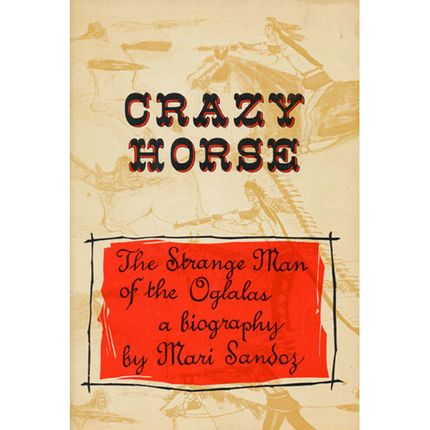
Crazy Horse, Mari Sandoz (1942)
For reasons that are often condescending and almost always corny, stoners have long had an affinity for Native American culture; something about the solidarity with countercultural underdogs, the dignity of a close connection to the natural world. Mari Sandoz’s biography of the Oglala Sioux military warrior is the rare book that feels empathetic, rather than merely sympathetic, to the plight of native people in the 19th century. It’s also full of absolutely gorgeous figurative language — traitors who sold their tongues to the white man; settlers who dig themselves into stony hills as turtles dig into sand. Crazy Horse is as purely evocative a piece of history as you’re ever likely to read; a book to wander around in.

Dark (2017–2020)
For new viewers, the less said narratively about Dark, the better; its twists and turns are glorious to experience for the first time. Putting aside plot specificities, then, what makes Dark such a fulfilling sci-fi experience is its sense of mood and how its production design evokes an ominous fairy tale of shadows punctuated with gashes of color (a yellow raincoat, a series of glowing lights in a forest), and its electronic score from Ben Frost adds to the overall unsettled, on-edge atmosphere. Louis Hofmann is a revelation as central character Jonas, a young man being pulled into a mystery by forces he half-recognizes, as if from a dream. Dark plays consistently along that edge of the real and unreal with a significant new development in each of its three seasons, and that ever-denser plotting is a joy to try and untangle, get irritated by, and then dive into again. (Available to stream on Netflix.)

The Dark Eidolon, Clark Ashton Smith (1935)
Become one with the quintessential bitterly orphaned underdog Narthos (and his prolific creator, Lovecraft pal and writer Clark Ashton Smith) as he transforms into mighty sorcerer of sorcerers Namirrha (a commander of devildom “direr than … pestilence”) and attempts to overthrow the dark powers that be in this classic of 1930s weird short fiction. Revisit the forgotten sorcery of sunken worlds while you formulate theories on the relationship between psychedelic experience and inventive entities beginning with the final letters of the alphabet: Xeethra (an ancient evil lord), Zothique (the only remaining dimly lit continent on Earth), Zylac (a city on this continent), Ummaos (the main town within this city), and Zotulla (Emperor of Zylac), for starters. In case Smith hasn’t already cast his spell, he also throws in an ornate giant skeleton, an invisible stallion, and legions of ruby-eyed rats and alarmingly welcoming mummies in the fight against Zotulla.
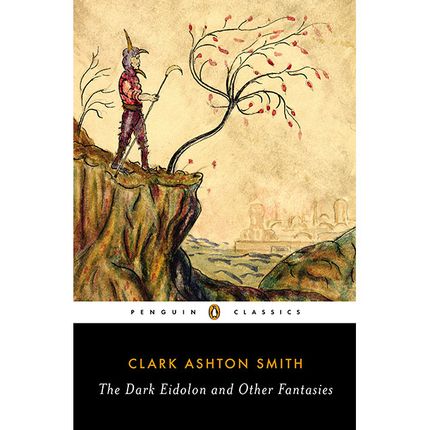
The Dark Eidolon, Clark Ashton Smith (1935)
Become one with the quintessential bitterly orphaned underdog Narthos (and his prolific creator, Lovecraft pal and writer Clark Ashton Smith) as he transforms into mighty sorcerer of sorcerers Namirrha (a commander of devildom “direr than … pestilence”) and attempts to overthrow the dark powers that be in this classic of 1930s weird short fiction. Revisit the forgotten sorcery of sunken worlds while you formulate theories on the relationship between psychedelic experience and inventive entities beginning with the final letters of the alphabet: Xeethra (an ancient evil lord), Zothique (the only remaining dimly lit continent on Earth), Zylac (a city on this continent), Ummaos (the main town within this city), and Zotulla (Emperor of Zylac), for starters. In case Smith hasn’t already cast his spell, he also throws in an ornate giant skeleton, an invisible stallion, and legions of ruby-eyed rats and alarmingly welcoming mummies in the fight against Zotulla.
Dazed and Confused (1993)
For his first widespread theatrical release, Richard Linklater had the hubris to stage a day-in-the-life panorama that didn’t try to change the lives of its protagonists or look for too much meaning in small-town youth. Perhaps that’s why, freshman hazing and drunken fisticuffs notwithstanding, Dazed and Confused doesn’t get weighed down with the enormous stakes of typical coming-of-age movies. Dazed is all about the little things — shaking hands after baseball games, virgin flirtations, unresolved angst — that trigger the feeling of being at the cusp of knowing who you are while freewheeling through and bumping up against other points of view. It’s high school inside out, to where Foghat starts to sound better than you remember. (Available to stream on Peacock and to rent on iTunes, YouTube, and Google Play.)

Dead in Long Beach, California, by Venita Blackburn (2024)
Venita Blackburn’s debut novel was released early in 2024, but it already feels like an essential entry in the stoner canon, not just for the heady subject matter (it’s about a writer named Coral who responds to texts as her brother after finding him dead) and Southern California setting, but for the high-concept structure. Dead in Long Beach, California is seemingly narrated by a race of aliens created by Coral in her hit novel Wildfire. Snippets from Wildfire (and even Wildfire fan fiction) are woven into the book. It’s a trippy read that unlocks on a whole other level if you’re reading a little baked.
Donuts, J Dilla (2006)
Many a rapper has waxed poetic about his love for marijuana (or lack thereof) over a Dilla beat. But sometimes it’s best to just let Dilla’s beat-making master class, Donuts, do the talking. Wanna know where Kanye West got some of his ideas? Look no further than “Light It,” Dilla’s 30-second reworking of Africa’s cover of the Doors’ famously censored single. And then get faded to the hypnotic sampledelica of “People” a few cuts later. Kanye himself once said Dilla’s music “sounded like good pussy.” Well, you know what? It sounds like premium kush, too.
Dopesmoker, Sleep (2003)
Featuring the world’s biggest, longest, slowest, heaviest mutating riff (or “visual landscape,” as fan Jim Jarmusch puts it) may be good for introspection or entering mythic realms — this album’s hour-long song involves a procession of weed priests “unearthing the creed of Hasheeshian,” and implores us to “drop out of life” and “follow the smoke to the riff-filled land.” (It’s an all-in, not-remotely-moderately-consuming experience, so we’re almost there already.) But chances are likely that head-banging or air-drumming or maximum zoning-out will take over from any mythmaking portents once you’re absorbed in once-defunct, again-crushing-it San Jose trio Sleep’s ultimate version of their doom-metal classic Dopesmoker, which is largely about hitting the bong as hard as possible to reach cannabis Zion.

Drifter (2014)
We’re in a golden age for comic fans who are also into pulpy sci-fi. In their 2014 collaboration, Brandon and Klein take the tired Western trope of the highly skilled lone cowboy far from home and shoot it off to the farthest reaches of the galaxy. Abram Pollux is the drifter in question, a man who crash-lands on an alien world that resembles an endless Sergio Leone movie set and gets pulled into an ongoing conflict while trying to figure out why he’s here and when, exactly, “now” is. It’s all topped off by Klein’s beautiful digitally created artwork, which calls to mind the more cosmically minded European comic masters of the ’70s and ’80s.
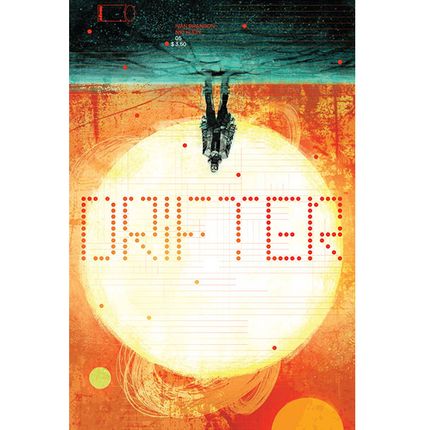
Drifter (2014)
We’re currently in a golden age for comic fans who are also into pulpy sci-fi. In their 2014 collaboration, Brandon and Klein take the tired Western trope of the highly skilled lone cowboy far from home and shoot it off to the farthest reaches of the galaxy. Abram Pollux is the drifter in question, a man who crash-lands on an alien world that resembles an endless Sergio Leone movie set and gets pulled into an ongoing conflict while trying to figure out why he’s here and when, exactly, “now” is. It’s all topped off by Klein’s beautiful digitally created artwork, which calls to mind the more cosmically minded European comic masters of the ’70s and ’80s.
Electric Ladyland, the Jimi Hendrix Experience (1968)
So many of the trippy albums from the psychedelic era sound today like a sort of twee playacting — as if frilling up a song with sound effects and singing about gnomes constituted true trippiness. The genius of Electric Ladyland, though, and the thing that lifts it above all other ’60s psych albums, is in how fully it captures, and then conveys, a stoned worldview. The sonic effects — all the stereo panning, the way the drums shimmer, that omnipresent wah-wah guitar — are placed with wizardly detail. The lyrics — even on the epic aquatic love story “1983 … (A Merman I Should Turn to Be)” — have an earthiness, a solidity, to them, free from any of that Professor Picadilly’s tangerine-tart whimsy that sank so many of the era’s songwriters. And Jimi’s vocals have a mystical, lagging quality, as if the words were coming to him in the half-instant before he sang them. All this adds up. Electric Ladyland isn’t the work of someone dillydallying with psychedelic signifiers, drooling while he futzes around with the crossfaders. It’s is an album made by a genius who spent years high, heard special music in his head, and then painstakingly translated it, or as much of it as he could, onto this eternal album.
Enter the Void (2009)
In director Gaspar Noe’s sensory overdrive film, a soul departs a murdered DMT fiend and wanders freely, but in a kind of purgatory, in an overwhelming Tokyo we experience through his eyes (er, disembodied psyche). Of course, you have to be ready to be inside a dead guy. Get dark and heavy and disoriented and accept the invocation of this “psychedelic melodrama” to enter the void. Travel to viscerally discombobulating places, roaming over rooftops and inside bodies (there’s an intrauterine view of a penis entering the reproductive system). Take in strip clubs, conversations about the Tibetan Book of the Dead, orgiastic hotel rooms, murder-scene bathrooms, and an incestuous past — sights and sounds that are alternately sexy and terrifying. Even the title sequence isn’t for the faint of heart. (Available to stream on AMC+ and to rent on iTunes, YouTube, and Google Play.)

The Exegesis of Philip K. Dick (2011)
In novels such as Do Androids Dream of Electric Sheep?, Ubik, and a small library of others, megaprolific sci-fi guru Philip K. Dick presented some of literature’s thorniest and most reality-melting conceits. The Exegesis of Philip K. Dick is one of them — with the added bonus of being real. In 1974, while recovering from the removal of some wisdom teeth, Dick — an avid speed user — began receiving mystical revelations from an entity he dubbed the Vast Active Living Intelligence System (that’s VALIS to you) and, graphomaniac he was, he got it all down on paper. “We’re not talking about a different way of being-in-the-world,” Dick wrote. “Or ever a better way; we’re talking about the lifting for the first time in human history of a massive perceptual/conceptual occlusion having to do with the ontological structuring factor we call causality …” Dude, I know! I KNOW!

The Exegesis of Philip K. Dick (2011)
In novels such as Do Androids Dream of Electric Sheep?, Ubik, and a small library of others, megaprolific sci-fi guru Philip K. Dick presented some of literature’s thorniest and most reality-melting conceits. The Exegesis of Philip K. Dick is one of them — with the added bonus of being real. In 1974, while recovering from the removal of some wisdom teeth, Dick — an avid speed user — began receiving mystical revelations from an entity he dubbed the Vast Active Living Intelligence System (that’s VALIS to you) and, graphomaniac he was, he got it all down on paper. “We’re not talking about a different way of being-in-the-world,” Dick wrote. “Or ever a better way; we’re talking about the lifting for the first time in human history of a massive perceptual/conceptual occlusion having to do with the ontological structuring factor we call causality …” Dude, I know! I KNOW!
Fragile, Yes (1971)
Pot and pseudo-profundity go together like pot and finger food, and there’s no more pseudo-profound album from the pseudo-profound, echt-awesome world of prog-rock than Fragile. Part of the pleasure is in the virtuosic playing — all those oddball time signatures and herky-jerky riffs, country-ish guitar licks splattered here, a lurching bass giddy-up there (RIP, Chris Squire), squiggly keyboards everywhere: It’s all maximum bombast, all the time. Then there’s lead singer Jon Anderson’s elfin voice, often featured in churchly harmony (and once in a while backwards) singing stuff like this: “Sharp! / Distance! / How can the wind with so many around me / Lost in the city.” It’s all so unabashed in its ridiculousness that it turns into something grandly moving, in the way that you might get stuck staring at a skyscraper and think things like, People made that!
Friday (1995)
Despite its South Central L.A. setting, this’95 comedy transcends the hood-movie genre because, at its core, it’s about friendship, family, maturity, and smoking weed — true universals. Along the way of this day in the life of newly unemployed Ice Cube — fired on his day off! — viewers meet a menagerie of oddball characters and learn valuable stoner lessons from Chris Tucker’s Smokey: “Puff, puff, give” is proper rotation etiquette, mixing weed with angel dust is bad news, and never get high on your own supply, especially when you owe Big Perm, er, Big Worm. If only getting high gave everyone the strength to knock out the community bully. One can dream. (Available to rent on Amazon, iTunes, YouTube, and Google Play.)
From the Ages, Earthless (2013)
In the same way that maximum musical density and detail can be absolutely absorbing when your neurons are cloudy, intense, stripped-down purity can also grab the stoned mind and not let it go. On 2013’s From the Ages, Earthless, an instrumental and largely improvisational hard-rock band from San Diego, take the power-trio template of Age of Aquarius icons like Cream, the Jimi Hendrix Experience, and Blue Cheer and rid it of anything that might get in the way of true heaviosity — pop structures, time constrictions (the best performance here is the longest, the 30-minute title track), vocals, and lyrics. From the Ages is just a drummer, bassist, and guitarist ripping, and it’s incredible.
G-Funk Classics Vol. 1 & 2, Nate Dogg (1998)
Long before this legendary West Coast singer passed away in 2011, he’d been chopping it up with weed aficionado Snoop Dogg since his 213 days. And it seems like the latter rubbed off on Nate Dogg. Case in point: “Bag O’ Weed” — no, not the song from Family Guy, the one from Nate Dogg’s debut album. It’s more or less the original “Trap Queen,” a guide to wining and dining your woman with — what else? — weed. (But, like Nate says, she’ll have to bring the actual bottle of wine.) The pot-infused sounds of ‘90s G-Funk don’t get any smoother or more sinuous than this.

Golden Hour, Kacey Musgraves (2018)
Thank God someone picked up Willie Nelson’s stoner country mantle. After duetting with the man himself on 2015’s Pageant Material, Kacey Musgraves followed up with her most blissed-out album, Golden Hour. It’s sunny, easygoing, and full of wonder — perfect to lose an afternoon to.
Harold & Kumar Go to White Castle (2004)
Who’d have thought that the punch line of Neil Patrick Harris as an unhinged version of himself would still land 11 years later, but for entirely different reasons? Such is the charmed life of Harold & Kumar, which glides along on the enormous goodwill of stars Kal Penn and John Cho, much like their alter egos briskly escape peril atop the hide of a CGI cheetah. Kumar unapologetically straddles reality and fantasy, creates entire worlds within the title characters’ quest that mainly serve extended gags about swinger rednecks, hot women pooping, and man-on-marijuana sex. But at its heart, Harold & Kumar is a classic underdog tale pleasantly perverted by pot. (Available to stream on Tubi and to rent on Amazon, YouTube, iTunes, and Google Play.)
High Maintenance (2012-2020)
High Maintenance, the HBO comedy series about a New York City weed dealer and the oddballs to whom he deals, is more than just a show about marijuana. It’s a show that uses the drug to depict the strange, uncomfortable, and joyous ways that people in big cities connect to one another — all of which is pretty trippy when you really stop to consider it. The original web episodes are tidy and short — each between five and twelve minutes — and thus perfect for binge-watching with an impaired attention span. (Available to stream on Max and to purchase on Amazon, iTunes, and YouTube.)
Holy Motors (2012)
A wondrous and frustrating 2012 film from anarchic French provocateur Leos Carax, full of harshly disruptive textures and surreal conceits, and the extraordinary feral physical presence of lead actor Denis Lavant, with the perfect density of did-I-just-see-that moments and obscurity. Oscar (Lavant) fulfills “appointments” by cruising around in a limo and adopting various guises: a beggar; a mournful-then-funky accordionist; a motion-capture actor with gymnastic fighting skills who can’t handle treadmills and has the sensuality of a snake; a grotesquely violent, sushi-loving, couture-craving sewer leprechaun. Oscar gets into inexplicable confrontations, disconnected vignettes that offer us the ultimate realization that … well, that life requires a series of elaborate performances, some sensible and some not, some offering sensual or sentimental delights, while others lead to gnawed-off fingers and the gutter. (Available to stream on Pluto TV, Tubi, and to rent on iTunes and YouTube.)
Homo Sapiens Sapiens, Pipilotti Rist (2005)
Laying on one’s back to best see a work of art might instantly indicate great shape-shifting possibilities. Maybe that’s why all ceiling paintings trigger head trips, daydreams, and hallucinations. All that happened in Venice (at the 51st Biennale), one of the heavenly seats of ceiling painting — we pledge allegiance to Tiepolo and Tintoretto — in the Baroque church of San Stae on the Grand Canal in 2005. One could spend hours gazing up at Pipilotti Rist’s enormous video of a prelapsarian Adam and Eve dreamscape of figures singing, swimming in gardens, floating on clouds. The best ceiling fresco made in recent times. And that’s including the paintings of Venice in the Venetian in Vegas — although almost every painting in Sin City is a trip.
House of Balloons, the Weeknd (2011)
“You wanna be high for this,” Abel Tesfaye assures in the first moments of House of Balloons — an opening-track mission statement if there ever was one. Though there are references to all sorts of pills and powders scattered throughout the Weeknd’s notoriously narcotic debut mixtape (representative song titles: “The Comedown,” “Glass Table Girls”), they’re really red herrings for Balloon’s true spirit-drug — just listen to those sunbursting synthesizers and slow-motion psych-rock riffs.
In a Silent Way, Miles Davis (1969)
So many of Miles’s distinct eras lend themselves to contemplation: the sparse modal playing of Kind of Blue, the throbbing mystery of mid-’70s fusion efforts like Agharta, even the tone poems of Sketches of Spain. In a Silent Way,though, is the Miles album that feels most apt for laying around, just listening, as the man’s ghostly trumpet snakes its way through quietly bubbling electronic soundscapes. This is jazz as spooky ambient drift.

Inherent Vice, Thomas Pynchon (2009)
Think of Pynchon’s hero, the beach-bum P.I. Doc Sportello, as Philip Marlowe with potent joints substituted for the neat whiskeys. As Doc drifts through 1970s L.A. tracking the operations of the Golden Fang, which might be a Chinese shipping concern, a cartel of evil dentists, a heroin ring, or all three and more, it turns out paranoia is a detective’s best friend. (As Paul Thomas Anderson’s faithful 2014 adaptation showed, an unimpaired ability to follow Inherent Vice’s plot isn’t required to enjoy it.)
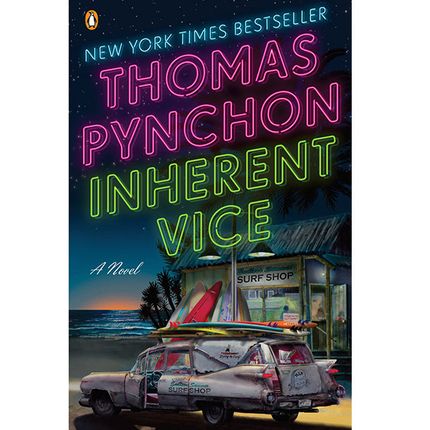
Inherent Vice, Thomas Pynchon (2009)
Think of Pynchon’s hero, the beach-bum P.I. Doc Sportello, as Philip Marlowe with potent joints substituted for the neat whiskeys. As Doc drifts through 1970s L.A. tracking the operations of the Golden Fang, which might be a Chinese shipping concern, a cartel of evil dentists, a heroin ring, or all three and more, it turns out paranoia is a detective’s best friend. (As Paul Thomas Anderson’s faithful 2014 adaptation showed, an unimpaired ability to follow Inherent Vice’s plot isn’t required to enjoy it.)
Instrumentals, Clams Casino (2011)
Clams Casino (born Mike Volpe) is a producer who helped create a mini-movement of thick, celestial music for rappers like Soulja Boy, Lil B, and A$AP Rocky back in 2011. But Volpe’s purple beats are far more affecting on their own, collected in a psychedelic little package where dreamy melodies pierce through thick fog. Grab your noise-blocking headphones and a bunch of pillows.
Jodorowsky’s Dune (2014)
What better way to contemplate your own impossibly epic stoner idea than to watch Frank Pavich’s documentary about psychoshamanic filmmaker-guru Alejandro Jodorowsky’s failed-but-beautiful decade-long attempt to mount one of his own. In this case, we’re talking about a colossal adaptation of Frank Herbert’s Dune that was never to be, by a guy who never bothered to read Dune in the first place (one of his many inspirational maverick gestures). For shame, uncooperative Hollywood studios! Journey along with this lifelong enfant terrible, playful reality-checker, and most-dynamic-ever talking head, and check out enthusiasm, ambition, and insane chutzpah at their most inspiring, as Jodo assembles a dream cast and crew (including Mick Jagger, Orson Welles, Salvador Dalí, and H.R. Giger) by wielding unparalleled magic charms — charisma, aura, persistence, creativity — and walking you through storyboards of what would have been the most cosmic shots ever. Zoom into the universe and give a two-bong salute to all beautiful things that go up in smoke. (Available to stream on Max or rent on Amazon, iTunes, YouTube, and Google Play.)
The Joy of Painting (1983–1994)
Bob Ross was a mild-mannered, soft-speaking artist whose half-hour painting tutorials were a PBS staple through the ‘80s, and for any kids who spent their summer breaks mostly indoors, they were an afternoon naptime essential. For misbehaving adults, though, watching Ross, who died in 1995, bring his “happy little” clouds, trees, and woodland creatures to life in his impossibly detailed landscapes was stoner nirvana. There’s nothing like watching Ross “beat the devil” out of his paint brushes to put your mind at ease. (Available to stream on Hulu, IMDb TV, and Tubi.)
Lawrence of Newark, Larry Young (1973)
The late ’60s and early ’70s were a golden age for jazz that traveled the spaceways, and then-contemporary albums by Sun Ra, Mahavishnu Orchestra, or Herbie Hancock’s brilliant Mwandishi band could’ve easily nabbed a spot on this list, but we’ll go with Lawrence of Newark as a stand-in for a style of music: hard electric jazz that ebbs and flows according to its own primordial logic. Especially on the monolithic “Khalid of Space, Pt. 2: Welcome,” Young, an endlessly inventive organist, throws down mighty slabs of sound that might make whoever was responsible for the Big Bang nod and say, “Dude, intense.”

Leaving the Atocha Station, Ben Lerner (2011)
The creative method employed by Adam Gordon, a young American poet living in Madrid in this funny and flaneur-y first novel, requires a cup of coffee and a dose of strong hashish first thing every morning. No surprise, then, that the book keeps looping back to the question of whether Adam, as a poet, as a lover, as a mostly high American abroad, is something of a fraud.

Leaving the Atocha Station, Ben Lerner (2011)
The creative method employed by Adam Gordon, a young American poet living in Madrid in this funny and flaneur-y first novel, requires a cup of coffee and a dose of strong hashish first thing every morning. No surprise, then, that the book keeps looping back to the question of whether Adam, as a poet, as a lover, as a mostly high American abroad, is something of a fraud.

Let’s Start Here, Lil Yachty (2023)
Lost in all the hubbub around Lil Yachty’s pivot from rap to psych-rock is just how druggy this album is. Pop an edible at the beginning, ride the easygoing vibes of “the ride-” and “running out of time,” and by the time you get to the trippier middle of the album, you’ll be “swirling and spinning,” as Yachty sings. Just be ready for the intense, extra-vivid climax of “IVE OFFICIALLY LOST ViSiON!!!!”
Light Up Gold, Parquet Courts (2012)
Once you’re blerg’d and bleary, get “Stoned and Starving” with the second album by these wordy and catchy Brooklyn-based Texan punks. On opener “Master of My Craft,” they remember that even “Socrates died in a fucking gutter,” and on “No Ideas,” a shrink tells them they know zilch — so, they figure, why not light up some Acapulco Gold and ramble on? Elsewhere, singer Andrew Savage teaches us rad ways of dealing with being a young aimless-jobless in the land of the oppressed — like declaiming just about everything one can about the experience of eating a tasty doughnut while avoiding a gnarly tumble into its ever-widening hole. Every tight riff leads to the next long before wearing out its welcome, and your confused inner voice will find good company here.
Lo Borges, Lo Borges (1972)
Along with the better-known Milton Nascimento, among others, Lo Borges came out of the thriving, exploratory early ‘60s–’70s Clube da Esquina music scene of the Brazilian state of Minas Gerais. Unlike their countrymen in the contemporary tropicalia movement (Gilberto Gil, Os Mutantes), the Minas Gerais musicians favored languid drift and golden melody over genre-busting and discordance, and Lo Borges is as good an album as the moment produced. A deeply mellow breeze of liquid guitar, lullaby melodies, gently funky rhythm, and tropical languor, this is perfect swaying-on-a-hammock music.
Lonerism, Tame Impala (2012)
The Australian rockers’ breakthrough second album is all about texture. From the panting opening of “Be Above It” to the appropriately warm close of “Sun’s Coming Up,” every second of the record is enveloped in fuzz, cracks, and reverberating synths. Front man Kevin Parker’s wispy vocals act as an anchor amid the spiraling, sun-bleached soundscapes that even the most alert listener can’t help but get lost in. Lonerism is one of the few psych-rock albums of recent years that you could play for sober friends without embarrassment.
The Long Goodbye (1973)
When he adapted Raymond Chandler’s 1953 novel, Robert Altman intended his Philip Marlowe to be a man out of time — the reluctantly honorable P.I. was meant to be no match for the New Age selfishness of ‘70s L.A. And he isn’t! But with his hangdog expression, constant mumbling, and easygoing vibe — his catchphrase: “It’s okay by me” — Altman wound up creating another pop-culture archetype: the stoner detective. (Available to stream on Pluto TV, Tubi and to rent on Amazon and iTunes.)
Lucas Bros. Moving Co. (2013–2015)
There’s laid-back, and then there’s the Lucas Brothers, two deadpan twins who created, write, and star in the FXX series Lucas Bros. Moving Co. The animated brothers are rarely without weed for long, and their surreal adventures through gentrifying Brooklyn are filled with digressive side quests that maintain a stoner’s perfectly loopy internal logic. (A typical episode finds them entering a soul-food cook-off, which means they have to journey to Hell to get back their souls, which they’d sold to the devil so they could beat Mortal Kombat.) And when they do give up smoking weed, they find it turns them into Matrix-style superheroes who eventually turn evil — all the more reason to never quit. (Available to purchase on Amazon, YouTube, and iTunes.)
MacGruber (2010)
This unceasingly riotous action-movie parody can be viewed in any state, but the aura and intensity of Will Forte as MacGruber — who is actually kind of the villain of this movie — is mind-blowing. References to Die Hard, Rambo, Roadhouse, and, yep, MacGyver make for one of the most detailed comedies in recent memory, though you will never notice it underneath MacGruber’s surprising emotionalism: “Tell me what you want me to fuck!” It pushes for the extremes in every way and is sort of just riotous scene after riotous scene until it ends. (Available to stream on Prime Video and purchase on Amazon, iTunes, YouTube, and Google Play.)
Maggot Brain, Funkadelic (1971)
The third album by George Clinton’s original Funkadelic lineup begins by explicitly encouraging our participation in the birth of dormant Earth magic: We’ve knocked her up again, so let’s raise the child right. Thankfully, you’ll feel safe poking your heads above ground (like the album’s cover star, Barbara Cheeseborough) once Eddie Hazel’s beautifully warped soloing over lullaby fingerpicking kicks in on the ten-minute title track, delayed and decayed and intensely emotional. The rest is heavy but also comfy, with tons of joy and life affirmation and yuks, a synergized funk rich with surprises: flatulence, robo-bass, cuckoo clocks, the lowing of cows, tilt-a-whirl organ, and Latin percussion leading to furious guitar shredding on “Super Stupid,” high-energy proto-metal about losing the fight to fear, and just one of this record’s many perfect incongruities for the scrambled brain.
The Matrix (1999)
The Wachowskis’ influential sci-fi classic is an out-of-body experience about out-of-body experiences — Keanu Reeves plays a seemingly ordinary man who learns that his life is an illusion, and that he and the rest of humanity are sharing a collective dream powered by evil sentient machines. Here’s a movie that, for all its calls for liberation, secretly indulges in the glories of virtual reality. The Matrix might be a dystopian construct, but it’s a cool dystopian construct — one in which we know kung-fu, can go through walls, get to fly helicopters, and have every gun imaginable at our disposal. We get to do all that … without even so much as standing up in real life. That’s a stoner’s dream. (Available to stream on Max and Netflix and to rent on Amazon, iTunes, YouTube, and Google Play.)
McCartney, Paul McCartney (1970)
Bummed out after the Beatles’ breakup, Paul McCartney cheered himself up in his home studio by laying down a dozen songs even less baked than the ones on Side 2 of Abbey Road (plus, well, “Maybe I’m Amazed”). McCartney himself, though, sounds like he was fully baked, especially on shaggily charismatic glorified demos like “Every Night,” “Man We Was Lonely,”and “Teddy Boy,” whose endings seem to come way before they’re supposed to, like Paul forgot what he was doing and just quit playing. Listening to this album is (probably) the closest you’ll ever get to smoking up at a Beatle’s house.
Merriweather Post Pavilion, Animal Collective (2009)
In this case, you can 100 percent judge an album by its cover: Indie-rock art weirdos Animal Collective’s eighth album is adorned with what looks like a freaking Magic Eye. The music is fittingly wobbly and full of seeming aural illusions, as wave upon wave of dub and dance-music recording techniques are somehow stuffed into harmony-rich songs that, at their core, wouldn’t be too weird on Pet Sounds.

The Best of Milligan & McCarthy (2013)
Former art-school students Milligan and McCarthy produced some of the most bizarre (and punk-rock) comics to ever come out of the U.K., pushing their imaginations and those of their readers are far as they could without snapping. From existentially adrift superheroes focused on making the tabloids to a Philip K. Dick–inspired drag race through Indian mythology, there wasn’t a concept or archetype that Milligan could resist gleefully deconstructing. On the art side, McCarthy (who helped write and did design work on Mad Max: Fury Road) kept going further and further down a surreal rabbit hole until each and every page felt like its very own universe.
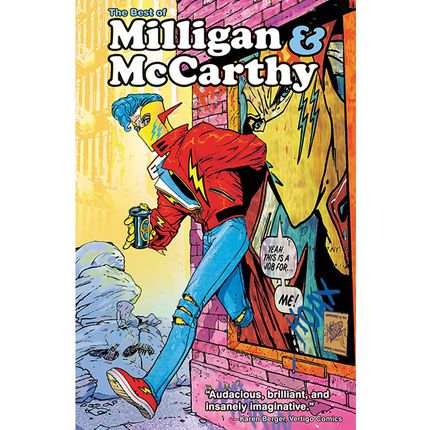
The Best of Milligan & McCarthy (2013)
Former art-school students Milligan and McCarthy produced some of the most bizarre (and punk-rock) comics to ever come out of the U.K., pushing their imaginations and those of their readers are far as they could without snapping. From existentially adrift superheroes focused on making the tabloids to a Philip K. Dick–inspired drag race through Indian mythology, there wasn’t a concept or archetype that Milligan could resist gleefully deconstructing. On the art side, McCarthy (who helped write and did design work on Mad Max: Fury Road) kept going further and further down a surreal rabbit hole until each and every page felt like its very own universe.

Minions (2015)
When you’re sober, the charm of these little yellow guys may not strike you. But smoke even just little, and they’re great. These jaundiced jokesters may have oversaturated the market, but that’s not their fault. Their made-up language is goofy, and their resistance to pain opens whole avenues of physical comedy. They’re canonically immortal and have lived unchanged since the dinosaurs; isn’t that fascinating? The 2015 movie Minions is basically a silent comedy in the style of Harold Lloyd (same glasses), the weird memes boomers post are essentially metacomedy, the tie-in foods are always that weirdly satisfying artificial-banana flavor. And the cover of “Bang Bang” on the Rise of Gru soundtrack? Slaps. Sorry, Jack Antonoff haters. (The Minions movie is available to stream on Netflix.)

Miserable Miracle, Henri Micheaux (1956)
In the arcane tradition of Thomas De Quincey’s 1821 work Confessions of an English Opium-Eater, this slim nonfiction book by a Belgian polymath diaries one man’s narcotic self-experiments. Here, the active agent is mescaline. The result is a fantastically surreal volume of alternately hyperdetailed and jibber-jabber drug recollections, along with drawings of his hallucinations and marginalia that signifies who knows what. It’s a report back from a journey into the mind’s deepest recesses — and it actually ends up being pretty funny. “Another pause … could it be finished?”
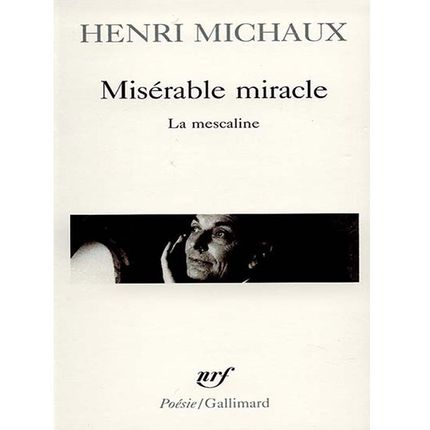
Miserable Miracle, Henri Micheaux (1956)
In the arcane tradition of Thomas De Quincey’s 1821 work Confessions of an English Opium-Eater, this slim nonfiction book by a Belgian polymath diaries one man’s narcotic self-experiments. Here, the active agent is mescaline. The result is a fantastically surreal volume of alternately hyperdetailed and jibber-jabber drug recollections, along with drawings of his hallucinations and marginalia that signifies who knows what. It’s a report back from a journey into the mind’s deepest recesses — and it actually ends up being pretty funny. “Another pause … could it be finished?”
New Amerykah Pt. 2: The Return of the Ankh, Erykah Badu (2010)
Slow, sensuous, and oozing with Earth-Mother wisdom, Fat Belly Bella’s latest album is a blissed-out masterpiece. This is Badu at her most comfortable, serving a rare blend of confessional and confident, deeply personal and omniscient across meandering neo-soul song structures. Then there’s the cover art, which pictures a nude Badu crawling out of the futurist garden-brain of a robot version of herself.

On Being Blue, William Gass (1975)
Ever think about what colors mean? Postmodern literary macher William Gass sure did. This gorgeous little volume is 96 pages of genius wordplay and genius-er thinking about “blue” in all its various and enigmatic meanings. Here’s how it starts: “Blue pencils, blue noses, blue movies, laws, blue legs and stockings, the language of birds, bees, and flowers as sung by longshoremen, that lead-like the skin has when affected by cold, contusion, sickness, fear; the rotten gum or gin they call blue ruin and the blue devils of delirium; Russian cats and oysters, a withheld or imprisoned breath, the blue they say that diamonds have …”
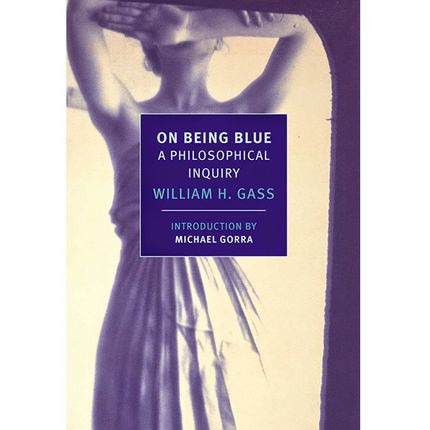
On Being Blue, William Gass (1975)
Ever think about what colors mean? Postmodern literary macher William Gass sure did. This gorgeous little volume is 96 pages of genius wordplay and genius-er thinking about “blue” in all its various and enigmatic meanings. Here’s how it starts: “Blue pencils, blue noses, blue movies, laws, blue legs and stockings, the language of birds, bees, and flowers as sung by longshoremen, that lead-like the skin has when affected by cold, contusion, sickness, fear; the rotten gum or gin they call blue ruin and the blue devils of delirium; Russian cats and oysters, a withheld or imprisoned breath, the blue they say that diamonds have …”

On Hashish, Walter Benjamin (2006)
Around the age of 35, Walter Benjamin began experimenting with hashish, opium and mescaline. Of his first time on hashish, he wrote, at 3:30 a.m. on December 18, 1927: “Unlimited goodwill. Suspension of the compulsive anxiety complex. The beautiful ‘character’ unfolds. All of those present become comically iridescent. At the same time one is pervaded by their aura.” The fun continued for seven years.

On Hashish, Walter Benjamin (2006)
Around the age of 35, Walter Benjamin began experimenting with hashish, opium and mescaline. Of his first time on hashish, he wrote, at 3:30 a.m. on December 18, 1927: “Unlimited goodwill. Suspension of the compulsive anxiety complex. The beautiful ‘character’ unfolds. All of those present become comically iridescent. At the same time one is pervaded by their aura.” The fun continued for seven years.
Pilgrim at Tinker Creek, Annie Dillard (1974)
Pulitzer Prize–winner Dillard’s best-known nature writing shows her mastery of what amounts to supernaturally close observation, the kind of looking that changes both the seer and the seen. Whether it’s moths, preying mantises, meadows, or her own cat — a born killer, like all cats — Dillard’s prose conveys the transcendent power of really, like really, looking.

Pilgrim at Tinker Creek, Annie Dillard (1974)
Pulitzer Prize–winner Dillard’s best-known nature writing shows her mastery of what amounts to supernaturally close observation, the kind of looking that changes both the seer and the seen. Whether it’s moths, preying mantises, meadows, or her own cat — a born killer, like all cats — Dillard’s prose conveys the transcendent power of really, like really, looking.
Pineapple Express (2008)
When Judd Apatow enlisted moody indie drama wunderkind David Gordon Green to direct this bizarre caper comedy about a stoner (Seth Rogen) and his dealer (James Franco) who wind up running afoul of ruthless drug gangs, nobody quite knew what to expect. The result was a stoner classic — not because of the obviously weed-heavy story line but because of Green’s fondness for playing with the rhythms of the movie and with audience expectations. Pineapple Express jumps from slapstick to absurdism to balls-out action — if you’re sober, it’s just plain weird. (Available to stream on Netflix or rent on Amazon, iTunes, YouTube and Google Play.)
Promethea (1999–2005)

Over the course of 32 issues, college student Sophie Bangs — the latest person to take on the mantle of the superherolike harbinger of the apocalypse Promethea — guides readers through an exploration of comics god Alan Moore’s personal thoughts on philosophy, spirituality, mysticism, and the occult. The writing is always wild but it’s the book’s art that really earns its place here. Artist J.H. Williams’s work is experimental from the start, but by the end, he’s doing outlandish things with page design and color that no comics artist before him had even thought of, culminating in a final chapter that can be read as a standard comic or reassembled into a gigantic poster-size document.
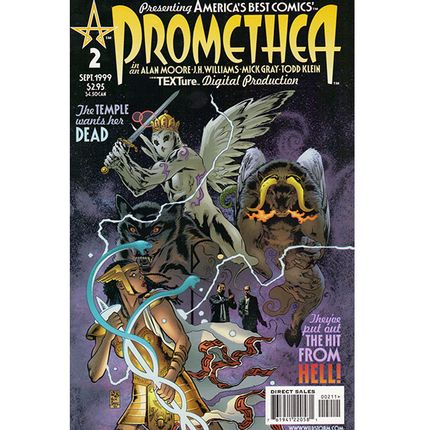
Promethea (1999–2005)
Over the course of 32 issues, college student Sophie Bangs — the latest person to take on the mantle of the superherolike harbinger of the apocalypse Promethea — guides readers through an exploration of comics god Alan Moore’s personal thoughts on philosophy, spirituality, mysticism, and the occult. The writing is always wild but it’s the book’s art that really earns its place here. Artist J.H. Williams’s work is experimental from the start, but by the end, he’s doing outlandish things with page design and color that no comics artist before him had even thought of, culminating in a final chapter that can be read as a standard comic or reassembled into a gigantic poster-size document.
Rick & Morty (2013–present)
Rick and Morty is like a stoner’s take on Family Guy through the lens of Dan Harmon. Based on the time-traveling, galaxy-jumping adventures of a boy named Morty and his mad-scientist grandfather Rick — sort of an unfeeling, more senile version of Back to the Future’s Doc Brown — Rick and Morty serves as part parody, part absurdity, always following weirder paths than Seth MacFarlane would ever entertain. Consider this another show sprung forth by the big bang of this genre: Sideshow Bob stepping on the rake. (Available to stream on Max, Hulu and to purchase on Amazon, iTunes, YouTube, and Google Play.)

Riddley Walker, Russell Hoban (1980)
The basics of the criminally underappreciated Hoban’s whatever’s-worse-than-criminally underappreciated postapocalyptic novel are bonkers enough on their own: 2,000 years after a nuclear war, society has entered another Dark Ages, and a teenage boy becomes entangled in a race to re-create firearms. The sentences, though — written in a kind of pidgin English — are what makes Riddley Walker so unique, and they’re more rewarding the longer you spend in their company:
“Seams like I ben all ways thinking on that thing in us what thinks us but it dont think like us. Our woal life is a idear we dint think of nor we don’t know what it is. What a way to live.”
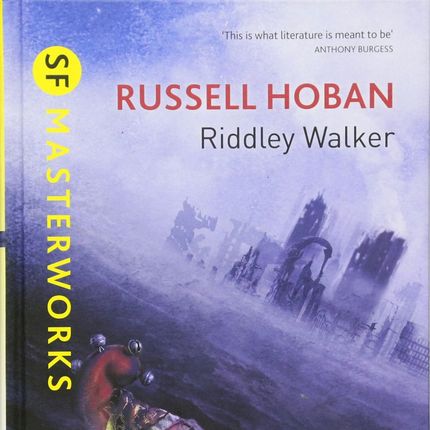
Riddley Walker, Russell Hoban (1980)
The basics of the criminally underappreciated Hoban’s whatever’s-worse-than-criminally underappreciated postapocalyptic novel are bonkers enough on their own: 2,000 years after a nuclear war, society has entered another Dark Ages, and a teenage boy becomes entangled in a race to re-create firearms. The sentences, though — written in a kind of pidgin English — are what makes Riddley Walker so unique, and they’re more rewarding the longer you spend in their company:
“Seams like I ben all ways thinking on that thing in us what thinks us but it dont think like us. Our woal life is a idear we dint think of nor we don’t know what it is. What a way to live.”
Sacred Mirrors, Alex Grey (1979–1989)
Are Grey’s paintings good art? Probably not. Are they near-perfect representations of stoned perception? Hot-diggity they are! If Grey’s work looks familiar, that’s because it’s become iconic for other altered-states-friendly musicians. (Tool, Nirvana, and the Beastie Boys, among others, have used Grey’s paintings for their album art.) And it’s easy to grok why. Faux x-ray, saturated colors, body-obsessed, lots of radiating lines — Grey’s “visionary art” is a straightforward translation of psychedelic sight — which, in the appropriate state, makes it perfect to look at for hours and hours and hours and hours.
Salad Days, Mac DeMarco (2014)
The summery Salad Days is the perfect soundtrack for a day, week, month, or life of lounging. Each of the record’s 11 hummable songs haphazardly meanders along, never attempting to be anything bolder than its own deceptively simple self. The result, chock-full of lolling bass lines, twinkling guitars, and sunburnt synths, is effortlessly charming, and the introspective lyrics are surprisingly poignant. These are the kinds of songs you’ll still be quietly singing to yourself long after you’ve come back to sober.
Sandinista, the Clash (1980)
Released as a triple LP in 1980, the Clash’s fourth album found them abandoning the rock power of London Calling and indulging in a number of different genres: traditional reggae, folk, soul, dance, jazz, gospel, you name it. (Smoke it if you got it, the saying goes, and this band had it all.) The last dozen tracks, beginning with “Lose This Skin,” are where the album really goes boners, with forays into dub and a rendition of their earlier scorcher “Career Opportunities” sung this time by a couple kids. If you have the vinyl version, look at the runoff groove in the center: You’ll find etched-in words that, over the six sides of the records, add up to “In space, no one can hear you Clash.”

The Savage Detectives, Roberto Bolaño (1998)
Bolaño’s elliptical novel centers around a group of intellectuals called the Visceral Realists and the community they inspire — broken up into three parts, it’s probably easiest to think about The Savage Detectives as three books. The second passage, which magically floats from perspective to perspective depicts the group’s freewheeling and essentially inconsequential philosophies; the third portion climaxes (satisfyingly!) with a completely inscrutable line drawing.
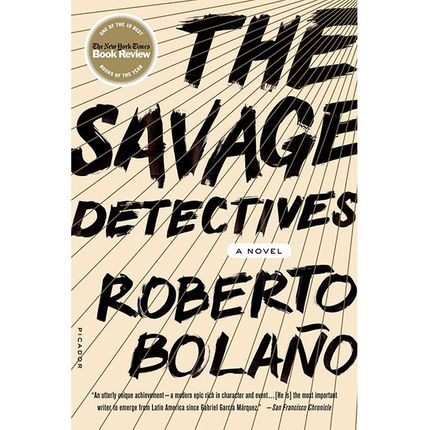
The Savage Detectives, Roberto Bolaño (1998)
Bolaño’s elliptical novel centers around a group of intellectuals called the Visceral Realists and the community they inspire — broken up into three parts, it’s probably easiest to think about The Savage Detectives as three books. The second passage, which magically floats from perspective to perspective depicts the group’s freewheeling and essentially inconsequential philosophies; the third portion climaxes (satisfyingly!) with a completely inscrutable line drawing.
Seinfeld (1989–1998)
Over its 169 episodes, there are already enough belly laughs to leave you sore. But think about it: Could you muster up the gumption to order from the Soup Nazi? What would you do if you were pretending to be a marine biologist and you happened to stumble upon a beached whale? Or if dazed musing isn’t your thing, you can just giggle at the ‘90s outfits and ponder how many of the show’s plots would be quickly solved if the characters had cell phones. Either way, Seinfeld shows once and for all that that nothing is really something. (Available to stream on Netflix and to purchase on YouTube, iTunes, and Google Play.)
Selected Ambient Works Vol. II, Aphex Twin (1994)
It could be easily argued that this is really more of an acid album than a pot album, but don’t harsh our mellow, okay? On his earlier compilation Selected Ambient Works 85–92, British electronic music genius Richard D. James built up rigorously logical and surprisingly emotional structures of synth melody and rhythm machine flow. On Vol. II, all that’s left are the traces. An enigmatic wisp of keyboard here, the faintest pulse there. Miraculously, the emotion remains, and the result is music that never loses its melancholy nor its ruminative mystery.
The Silver Factory, Billy Name (1962–1968)
Almost everything that Andy Warhol touched between 1962 and 1968, when he worked in what is now referred to as the Silver Factory, had a pixie dust on it — a magic that not only changed the way that art looked to the world but had the revolutionary powers to change the way the world looked at art, as well as the way that people looked at the world. Anyone who entered this midtown space had a possibility of being transformed, consumed, eaten alive, or set free. What made this empire of origin so special was partly the look of its walls and elevator, all covered in aluminum foil by photographer Billy Name, the same Factory person who scavenged the famous ratty red couch where crashers crashed and films like Blow Job were made.

Silver Surfer (1966–present)
“Anywhere and Everywhere — Hang On!” promises the tagline on the Silver Surfer’s solo title, and that’s exactly what recent writer-artist team Dan Slott and Mike Allred have delivered. Yes, their freewheeling take on the character doesn’t veer that far from Jack Kirby’s original — a solitary hero travels space on his surfboard in search of ways to make up for the damage he helped wreak as, of course, the herald of Galactus — but the duo lets their stoic lead finally crack a smile and enjoy himself. When you can see all the awe-inducing planets and creatures the galaxy can offer, with your love interest (and reader stand-in) Dawn Greenwood at your side, why not hang a cosmic ten?
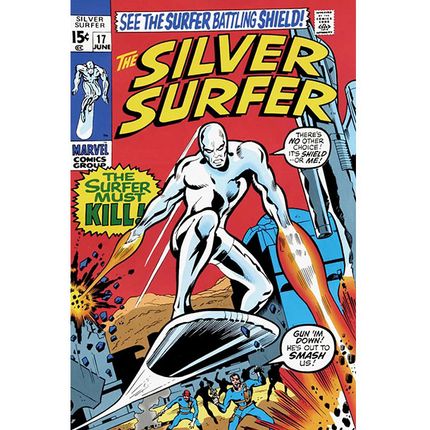
Silver Surfer (1966–present)
“Anywhere and Everywhere — Hang On!” promises the tagline on the Silver Surfer’s solo title, and that’s exactly what recent writer-artist team Dan Slott and Mike Allred have delivered. Yes, their freewheeling take on the character doesn’t veer that far from Jack Kirby’s original — a solitary hero travels space on his surfboard in search of ways to make up for the damage he helped wreak as, of course, the herald of Galactus — but the duo lets their stoic lead finally crack a smile and enjoy himself. When you can see all the awe-inducing planets and creatures the galaxy can offer, with your love interest (and reader stand-in) Dawn Greenwood at your side, why not hang a cosmic ten?
Skyspaces, James Turrell (late ’70s)
The artist James Turrell’s life work is an installation at Roden Crater, a volcanic cone in Arizona where Turrell is carving his masterpiece. Billed as a “naked eye observatory,” Roden Crater represents the culmination of a lifetime blending color, space, and optical illusion in some of the most demanded installations on the planet. But most of all … the light! SO MUCH LIGHT, MAKING ALL SORTS OF WILD-ASS SHAPES! Though his art can be overwhelming, there’s something magically human about it, too. And since Roden is basically impossible to get to, you might wanna start with Turrell’s far more accessible Skyspaces.
Smiley Face (2007)
Of all pothead paeans, Smiley Face most closely approximates a virtual-reality stoner experience. Anna Faris gives a laconic performance of epic proportions as Jane, an actress who inadvertently ingests pot cupcakes and sets off on proverbial misadventures. Directed from character actor Dylan Haggerty’s script by indie auteur Gregg Araki, Smiley succeeds in large part thanks to Faris, who’s one of the few actresses you’d pay to watch make bad choices for 90 minutes. But Araki also resists rendering Jane’s surroundings too broad, allowing her detours (not to mention “deep thought” digressions) to meander in relatable slow-motion while the movie as a whole breezes by in real time. Or, as Jane might assess it, “This situation is totally fucked. With a capital.” (Available to stream on Prime Video and Tubi)
Star Trek (1966–1969)
Does this really need justification? Fine: the Gorn. “The City on the Edge of Forever?” Tribbles. Mind-melding, alien gender politics and Harry Mudd. The music in the “Amok Time” koon-ut-kal-if-fee fight scene. Or, jeez Louise, what about just the endlessly bizarre rhythms of William Shatner’s acting? It’s free jazz being played by a world-historic ham, and endlessly fascinating. (Available to stream on Paramount+ and Pluto TV and to purchase on YouTube, iTunes, and Google Play.)
Step Brothers (2008)
Step Brothers is great because, unlike most big-budget Hollywood comedies these days, it’s not trying to teach you anything. The step brothers in this case — Will Ferrell as Brennan, John C. Reilly as Dale — are middle-aged losers in the throes of arrested development who are forced to come together because of a marriage. Though they start off as enemies, they establish a deep understanding through opera, activities, and a little venture called Prestige Worldwide. The surreal and rando humor of Step Brothers is a delight; the far-reaching absurdities like “How big is a bonito fish?” seem far less absurd the further out you’re willing to let yourself go. (Available to stream on Netflix or rent on Amazon, YouTube, iTunes, and Google Play.)
Stone Quackers (2014–2015)
This minimalist FXX cartoon is exactly what it says on the tin: It follows the delightfully wacky adventures of four anthropomorphic ducks, all of whom seem pretty stoned. Each ten-minute episode is made up of a group of loosely connected sketches; sometimes a woman plots to commit suicide alongside her pet cat, sometimes the day is saved with a choreographed dance to “What a Fool Believes,” and sometimes John C. Reilly pops up to voice a very John C. Reilly–esque cop (who is also a duck, natch). (Available to purchase on Amazon.)
Super Dave (1987–1991)
As if Evel Knievel wasn’t absurd enough, along came Super Dave Osborne, the legendary fake stuntman who somehow survived the dumbest of all death-defying acts, which usually involved getting crushed by large moving vehicles or falling from great heights without proper safety equipment. Comedian Bob Einstein (Albert Brooks’s older brother!) convincingly played the character from the early ‘70s on, becoming a recurring guest on a number of shows, including Carson’s and Letterman’s, and eventually hosting his own shows. A prototype for so many of Will Ferrell’s characters, Super Dave is relentlessly arrogant and bravely stupid, tossing off ridiculous dialogue that perfectly sets up his next magnificent failure. Just like Sisyphus, you know? (Currently unavailable to stream.)

Super Mario World (1990)
Thanks to the Nintendo Switch Online’s virtual console, you can now play the stoner classic Super Mario World on a console from this millennium. The game is so well designed (both in gameplay and in aesthetics) that it’s easy enough to play high — and in fact, a little herbal lift can be an asset. Just ask Justin “the Hog” McElroy.
Ta Det Lungt, Dungen (2004)
Mastermind Gustav Ejstes and his Scandinavian bros throw a bunch of entrancing elements in the air — fuzzy guitar, glistening strings, jazzy drumming, cascading melody — and let them land where they may. One song is decidedly Hendrixian, the next is melted Grateful Dead, then there are stately ballads and discordant sax jams — and because it’s all sung in Swedish, it’s sure easy to imagine the album’s Pagan rustic atmosphere as being the product of gnomes or elves or something. (This is a compliment, fair Swedes.)
Teletubbies (1997–2001)
Have you seen the most beautiful video on YouTube? It’s this video, a clip from Teletubbies edited to the tune of a Joy Division song. It really just makes you think, like [fffffffft] maybe lightness and darkness are always kind of the same thing and [fffffffft] in a way the sun really is an innocent baby looking down at our human foibles and laughing and [ffffffffft] I wonder where that baby is now [ffffffffft] I think there was a BuzzFeed article about where the baby is now but I forgot to click it [ffffffffft] I just hope the baby’s not dead, that would be depressing [ffffffffft] but yeah also isn’t it crazy how like [ffffffffft] Teletubbies paved the way for gay marriage kind of [ffffffffft] because our generation’s acceptance of gender fluidity began with our acceptance of Tinky Winky [ffffffffft] man, Teletubbiesreally changed the world [ffffffffft] I wonder if it’s streaming on Hulu. (Available to stream on Prime Video and Roku Channel .)
III, by Led Zeppelin (1970)
Whereas Zep’s first two albums hinted at their medieval nerdery, the quartet really indulged themselves on this LP, an album that redeems the old getting-it-together-in-the-country cliché. Written mostly at a remote Welsh cottage called Bron-Yr-Aur, the journey begins with Robert Plant’s Viking wails on “Immigrant Song” and veers into the bombastic minor-key plaints (“Since I’ve Been Loving You”), folk tales (“Gallows Pole”), bucolic Americana (“That’s the Way”), and ghostly blues (“Hats Off to (Roy) Harper”). Thanks largely to guitarist-producer Jimmy Page’s sonic ingenuity, it’s a cohesive record, drawing power from its alternating feelings of tension and tranquility. And if you can dig up a vinyl copy (clean the seeds off the spine), there’s plenty of delight to be found in the surreal album art, which was designed by a friend of Page’s named Zacron.
Tim and Eric Awesome Show, Great Job! (2007–2010)
Possibly the most divisive comedy duo since the Smothers Brothers got kicked off of CBS, the multifaceted, aggressive, and completely whacked-out stylings of Tim Heidecker and Eric Wareheim have left an indelible mark on stoner comedy the same way Mr. Show did a decade previous. Their range is wide — the demented cable-access nightmare Check It Out! With Dr. Steve Brule, the brutalistic 2-D satire of Tom Goes to the Mayor, Heidecker’s long-running anti-critic web series On Cinema — but the pair’s crown jewel, Tim and Eric Awesome Show, Great Job!, has left an indelible, hallucinatory mark on the genre that can be found in everything from Kroll Show to Portlandia. It might scare the shit out of you — that is, if you haven’t passed out from laughing too hard. (Available to stream on Max and to purchase on Amazon, iTunes, and YouTube.)
Toeachizown, Dam-Funk (2009)
The genius of L.A. session cat turned solo artist Dam-Funk is the way he finds the sonic and spiritual connections between ’70s pop-studio wizards like Todd Rundgren and funky ’80s R&B maestros like Zapp’s Roger Troutman. Over two discs and two hours of shining, intricate funk-pop, Dam marries obsessive attention to detail — every nook and cranny of this album is stuffed with smoker’s delights — to an implacable sense of groove. It’s ground and sky, melody and rhythm, hot and cool all at once. He’s worth seeing live, too, simply for the extended keytar solos.

Transformers vs. G.I. Joe (2014–2016)
Remember the endless sagas you would create with all your toys as a kid? Scioli and Barber’s Hasbro-approved story is the comic-book equivalent of that. The colorfully illustrated, whimsical war games between the eponymous toy lines may be a little lacking when it comes to logic or reason, but it’s unlikely that you’ll care. While the book could have ended up as just another craven corporate cross-over, its got a hyperactive spirit rarely present in mainstream American comics noawadays. Scioli’s art stands out, beautifully mixing meticulously detailed battle scenes ripped from an algebra notebook with the chunky psychedelia of Jack Kirby’s peak output.

Transformers vs. G.I. Joe (2014–present)
Remember the endless sagas you would create with all your toys as a kid? Scioli and Barber’s Hasbro-approved story is the comic-book equivalent of that. The colorfully illustrated, whimsical war games between the eponymous toy lines may be a little lacking when it comes to logic or reason, but it’s unlikely that you’ll care. While the book could have ended up as just another craven corporate cross-over, its got a hyperactive spirit rarely present in mainstream American comics noawadays. Scioli’s art stands out, beautifully mixing meticulously detailed battle scenes ripped from an algebra notebook with the chunky psychedelia of Jack Kirby’s peak output.
Ryan Trecartin (2005–present)
Of late, no one has better manipulated the changeable space between actual objects, digital imagery, millions of colors, aural distortion, cultural narrative, and the feeling of having one’s metabolism moving at the speed of an insect and seeing everything through dragonfly eyes than Ryan Trecartin. Beyond raves, Warhol, and hippie states of ecstasy, Trecartin makes life and Red Bull merge into dazzling digital displays that make one’s otherness awake and arise.
The Tree of Life (2011)
Early in Terrence Malick’s first directorial feature since 2005’s New World, ostensibly trippy scenes depicting dinosaurs and Earth’s formation help illustrate the hopelessness and healing that can come from appreciating our smallness in history. And they certainly set the tone for a heightened sensory experience. But what ensues is a story of great empathy for a middle-class Texan clan in post–World War II America, one pieced together the way real memories feel and operate: like patchworks of whispers, screams, soft light, and dark retreat that meet somewhere in time with our present selves. And, as Tree of Life’s ending might suggest, en route to reconciliation. It’s essential late-night transcendence that’ll certainly pair well with your glaucoma medicine. (Available to stream on Hulu, and to rent on Amazon, iTunes, YouTube, and Google Play.)
Twin Peaks (1990–1991)
Even 25 years after its premiere, Twin Peaks is still one of the strangest and most unique shows to ever air on television. And network TV, at that! Years before cable series began pushing the limits and before Adult Swim proved people weren’t afraid of the absurd or the surreal, David Lynch was shining a light on small-town America and showing how bizarre it could actually be. Plenty of other artists had implicated everyday citizens in tales of murder and deceit, but few had bothered to acknowledge all the freaks and weirdos that live there, too. No drug is going to make it make any more sense (could anything?), but it might make you more comfortable with the surrealism. (Available to stream on Paramount+ and to purchase on Amazon, iTunes and Google Play.)
2001: A Space Odyssey (1968)
Stanley Kubrick’s seminal 1968 sci-fi epic tracing the evolution of man from prehistory to the future — apes to astronauts — was a groundbreaking film for the sci-fi genre, for special effects, and for elliptical storytelling: All those lengthy scenes of spaceships slowly docking to stately classical music were arguably just as important as more typically plot-oriented scenes (to the extent that there were any). But Kubrick’s film was also, as it so happens, a watershed for stoner movies: An entire generation of flower children turned going to see 2001 into a national pastime. And who can blame them? The film’s elegant longueurs, its oblique narrative, its literally trippy special effects (particularly the infamous “Stargate” sequence, a dizzying, surreal roller-coaster ride through the cosmos) all made it a perfect movie to which one could tune out. (Available to stream on Max and to rent on Amazon, iTunes, YouTube and Google Play.)
Two-Lane Blacktop (1971)
Long before Drive (though just after Easy Rider), moviegoers were delivered director Monte Hellman’s (known up till then for his mid-’60s collaborations with a young Jack Nicholson) moody need-for-speed saga Two-Lane Blacktop. Come to see a floppy haired James Taylor (as the Driver) say “motherfucker” like he means it, but stay for Driver and drag-race buddy the Mechanic’s (Dennis Wilson) fluid series of close encounters with pixie runaways, hitchhiking oddballs, and humdrum Americana amid their cross-country horsepower showdown with rival gearhead G.T.O. (Warren Oates). The cumulative effect is akin to Slacker meets Cannonball Run along Route 66, on cruise control. (DVD available to purchase on Amazon.)
Ultraviolence, Lana Del Rey (2014)
None of that weak shit for Lana Del Rey: “I’ve got feathers in my hair,” she brags on the gloriously languid Ultraviolence, “I get high on hydroponic weed.” And given the record’s overall vibe, her story checks out — the whole thing feels like one gorgeously sustained exhale. Melodies billow out and float away, the tempo never exceeds “sleepwalking,” and a song rumored to be about Axl Rose literally just goes, “He loved guns and roses / Guns and roses / He loved guns and roses / He loved guns / And roses / Roses, roses.” We’ll have what she’s smoking.

Vine compilations (2017–present)
Vine may be dead, but it will live on forever thanks to the hard work of teenagers (and content farms) making compilations on YouTube. Those heroes are keeping alive a genre that exists exclusively for elder millennials who want to get stoned after our kids go to bed and relive the glory days of six-second comedy videos, and for that we thank them. Nothing is funnier to a high person than repeating a punch line ad nauseam, and the beauty of Vine’s shortened format is that punch lines come fast and furious. Before you’ve even finished singing, “Two bros chillin’ in a hot tub, five feet apart cuz they’re not gay,” Miss Keisha has left this mortal coil. TikTok could never.
Vocalcity, Luomo (2000)
Sensual disembodied voices are sliced and diced and rendered dub-wise here — moaning, gasping, sighing, and saying alluringly partial things like the elemental “because you move” or the resigned “nothing to do.” It’s as if Finnish “microhouse” pioneer Vladislav Delay (here called Luomo) were presenting warm, open-ended questions or invitations, and reconstituting it all amidst a thick and hypnotic house beat rich with a cornucopia of beautifully orchestrated teensy “clicks and cuts” (as genre specialists put it). Throughout the six long tracks of Vocalcity, it’s riveting. Though the shifts feel minimal and gradual, your ears will continually pick up on new shards — which you’ll love to swim in the swirl of — and your body won’t stop moving. It’s a gorgeous trip that finds languor amid clutter in the best way, and it’s a primo conversion tool for house-music naysayers: It ain’t just a thump, people.
Waking Life (2001)
Richard Linklater’s Waking Life is sort of a Eden. It combines internet-deep philosophizing — it’s like Metaphysics Lite — combined with an animation style that overlayed vivid animation and colors over real film. Waking Life is the college roommate who had watched Loose Change on a bender and thought it made some good points even if its general premise was unfeasible and its politics were outmoded. If weed is indeed a gateway drug, Waking Life is something like a gateway film. Please use in moderation. (It took a lot of restraint not to make a Baking Life joke here, by the way.) (Available to rent on Amazon, iTunes, YouTube and Google Play.)
The Weather Project, Olafur Eliasson (2003)
The sight of hundreds, sometimes thousands, of people laying on their backs, taking in Olafur Eliasson’s spectacular Weather Project, a gigantic red sunlike projection in the giant Tate Turbine Hall, was the apex of everything that Relational Aesthetics said it wanted to be: art, institutions, audiences, initiated and not, participating equally in a work of art. This simple E=mc⊃2; work was a blissfully confirming experience.
Weekend at Burnies, Curren$y (2011)
Paranoia? Cotton mouth? Awkwardness? Pass. Weekend at Burnie’s, the serene 2011 album from rap’s most prolific stoner, paints a different picture of what it’s like to smoke weed. For Curren$y, being high — and he’s always high — means being relaxed, sharp, confident, quick on the uptake, and surrounded by equally chilled-out friends and women preparing his next joint — stoned heaven.
Whose Line Is It Anyway? (1988–1998)
From high to lowbrow, the British improv game-show was tethered to reality, barely, by the dry wit of host Clive Anderson. The performers — the best of whom were Ryan Stiles, Greg Proops, Colin Mochrie, and Tony Slattery — showed off in-the-moment talents that had rarely been seen on-screen before, outside of the occasional slip-ups on live TV. Come for the jokes, stay for the instantly salvaged bloopers, and wonder how the hell these performers could be so funny so fast. (Available to stream on Amazon Prime and Tubi.)
Winged Migration (2001)

Woodshock (2017)
The debut film from sisters Kate and Laura Mulleavy, the minds behind the whimsical, weird fashion line Rodarte, is a forgotten A24 joint, a trippy thriller that bombed at the box office. But it’s a good, bizarre time, starring Kirsten Dunst as Theresa, a grief-stricken woman who decides to kill herself with five poisoned joints. After she smokes each one, odd things start to happen, including inexplicable acts of violence that Theresa doesn’t remember. A solid chunk of this movie is just Theresa tripping and wandering around dense forests, leaning on trees and lying down in moss, while the Mulleavys experiment with colored filters and dissolving transitions. Never has a paranoid freakout been this gorgeous to look at! (Available to stream on Tubi and Pluto TV.)

Workaholics (2011–17)
Admittedly, some part of the bro-y comedy of the Comedy Central sitcom hasn’t aged well; the 2010s really were a time for stoner comedy intermittently defaulting to homophobia for yuks. Workaholics is so pure-hearted, though, in its depiction of the best-friendship between roommates and co-workers played by Blake Anderson, Adam DeVine, and Anders Holm, and in its exploration of their ever-voracious appetite for more drugs, that it’s easy to love in spite of the flaws. The three have such perfect chemistry together, and the series gives them so many exceptional foils (like Kyle Newacheck, Jillian Bell, Erik Griffin, and Maribeth Monroe) that each episode passes like a breeze; there are only a few clunkers within its seven-season run. An acid-experimentation episode set during a business trip is a particular highlight. (Available to stream on Paramount+.)
The X-Files (1993–2002)
Do you want to believe? Few shows are easier to get lost in than this iconic ’90s conspiracy thriller, with the mythology-heavy adventures of FBI agents Fox Mulder (David Duchovny) and Dana Scully (Gillian Anderson) serving as the perfect catalysts for stoned-out, labyrinthine analysis. Just as enjoyable are the less-continuity-minded monster-of-the-week episodes, which are frequently creepy and sometimes unexpectedly funny. Sure, it goes off the rails near the end, but that doesn’t matter when you have Mark Snow’s memorable theme song, disturbing aliens, and the leads’ legendary, near-telepathic chemistry. (Available to stream on Hulu and to purchase on Amazon, iTunes, YouTube, and Google Play.)
Zardoz (1974)
Zardoz begins with the trippy image of a gigantic flying head booming, “The gun is good, the penis is evil!” and, amazingly, it only gets weirder from there. In John Boorman’s postapocalyptic satire, Sean Connery plays a brutally loinclothed warrior who infiltrates the ranks of the world’s elite and discovers that they’re a bunch of immortal upper-class twits who sit around an English country house complaining about how bored they are. When Connery massacres them at the end, they sigh in relief. Man, wouldn’t it be terrible to live forever? (Available to rent on Amazon, iTunes, YouTube, and Google Play.)